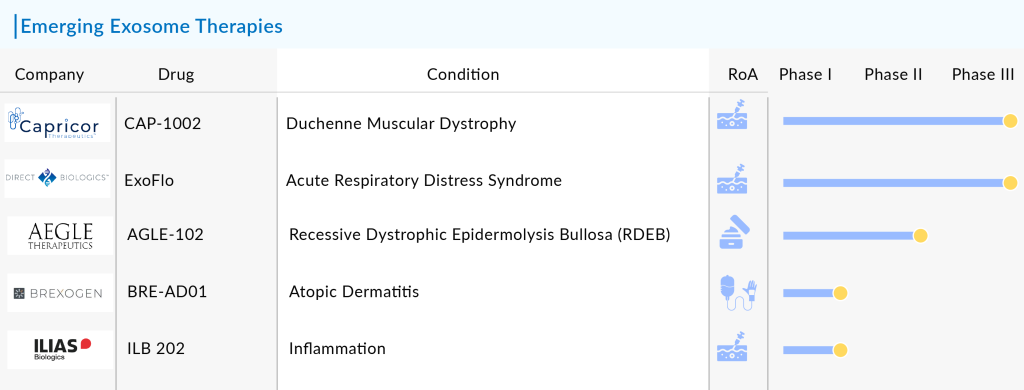Exosomes: Tiny Messengers with Big Potential in Medical Science
Oct 21, 2024
Table of Contents
Exosomes are tiny, powerful messengers that are revolutionizing the way we think about communication between cells. These nanosized vesicles carry crucial signals—proteins, lipids, and RNA—between cells, playing a pivotal role in everything from immune responses to tissue repair. What makes exosomes truly exciting is their potential in medicine: they can be harnessed for targeted drug delivery, diagnostics, and even treatments for cancer and neurodegenerative diseases. In the world of biotechnology, exosomes are the next big thing, unlocking a future where therapies are more precise, personalized, and effective!
Exosome: Functions, Biogenesis and Applications
Exosomes also known as extracellular vesicles serve as vehicles for the transfer of different molecules between cells and are involved in numerous physiological and pathological processes such as the removal of unwanted proteins, antigen presentation, genetic exchange, immune response, angiogenesis, inflammation, tumor metastasis, and dissemination of pathogens or oncogenes.
Downloads
Article in PDF
Recent Articles
- FDA Approves Sarepta’s Muscular Dystrophy Drug after Months of Debate
- Notizia
- Nucleic Acids and Gene Therapies in Neuromuscular Disorders: Next-Generation Therapeutic Strategies
- AbbVie Receives Approval; Kymriah Approved; Shire Gets USFDA Approval; NICE Rejects; Bristol-Myer...
- Sandoz’s Generic Revlimid; Agios’ Pyrukynd; Organon Announces 4Q & Full-year Earnings ...
Function of Exosomes
There is substantial evidence indicating that they function as significant biological signal messengers and transporters in both normal physiological functions and pathological processes, such as promoting primary cancer growth and stimulating angiogenesis. Here are the key functions of exosomes:
Intercellular communication: Exosomes containing cell-specific proteins, lipids, and nucleic acids may serve as a new mechanism for intercellular communication. This idea stems from the finding that exosomes released from parent cells can engage with target cells, subsequently affecting their behavior and phenotypic characteristics.
Mammalian reproduction and development: Exosomes in breast milk appear to support postnatal health and growth. These exosomes carry miRNAs that play a role in immune functions and can increase the number of T-regulatory cells derived from peripheral blood in vitro, potentially contributing to immune tolerance regulation.
Biogenesis of Exosomes
Exosomes are generated by the double invagination of the plasma membrane, resulting in the formation of intracellular multivesicular bodies (MVBs) filled with intraluminal vesicles (ILVs). When MVBs merge with the plasma membrane, these ILVs are released as exosomes. While several proteins and cellular elements play a role in this process, their precise functions remain unclear.
Application of Exosomes
Ongoing extensive research is focused on the role of exosomes in diagnosing and treating various diseases. The complex contents of exosomes provide a multi-faceted diagnostic approach for disease detection and monitoring. Additionally, exosomes have unique properties that enable them to deliver functional materials to diseased cells, making them promising therapeutic carriers.
Diagnostic Potential of Exosomes: Exosomes are present in all biological fluids and secreted by every type of cell, which makes them appealing for use as minimally invasive liquid biopsies. They offer the potential for ongoing sampling to track disease progression over time.
Drug Delivery Agents: A growing body of research indicates that, beyond serving as therapeutic agents themselves, exosomes can be viewed as effective biological vesicles for delivering biological therapeutics across various biological barriers to target cells efficiently.
Exosomes in Disease Diagnosis and Patient Pool
The patient pool for exosome research and therapies typically includes individuals with a variety of conditions, such as cancer, neurodegenerative diseases, cardiovascular disorders, skin conditions, and others.
As per DelveIsight analysis, in 2023, in the US, Duchenne muscular dystrophy cases were predominantly caused by large mutations, followed by small mutations, with the least cases attributed to point mutations.
As per the estimates, it has been observed that within a year, 5–10% of the patients with mild atopic dermatitis progress to moderate/severe patient pool. Additionally, it was found that epidermolysis bullosa affects males and females equally whereas atopic dermatitis is more significant in females than males.
Research has shown that exosomes can reflect the pathological state of their parent cells, making them valuable in identifying diseases such as cancer, neurodegenerative disorders, and cardiovascular diseases. For instance, tumor-derived exosomes can carry specific genetic alterations and protein markers, allowing for early detection and potentially facilitating personalized treatment strategies.
In addition to their diagnostic potential, exosomes offer a unique perspective on patient stratification and treatment response. Analyzing the exosomal content of patients can provide insights into the heterogeneity of diseases and the biological mechanisms driving them. This is particularly important in cancer, where the tumor microenvironment can influence therapeutic outcomes. By characterizing the exosomal profiles of different patient populations, clinicians can better identify which patients are more likely to respond to specific therapies, thus optimizing treatment plans and improving patient outcomes.
Promising Exosome Therapies on the Horizon
Exosomes could represent the next breakthrough in therapeutics. Research into exosome-based treatments is rapidly expanding, with the potential to transform various medical fields such as drug delivery, regenerative medicine, and diagnostic methods. The function of exosomes is entirely dependent on their donor cell origin and can have both beneficial or harmful effects. In regenerative medicine, particularly with cultured cell preparations, exosome research shows potential as a disease-modifying approach for autoimmune disorders. However, it’s crucial to note that exosome therapies are not yet FDA-approved and should be restricted to research settings or FDA Biologics License Applications.
Exosome-based treatments offer a promising alternative to CAR-T therapies, with early studies suggesting that exosomes derived from CAR-T cells may overcome current obstacles. These exosomes can be engineered to possess therapeutic properties while maintaining the targeted action of CAR-T cells, effectively equipping them to fight cancer.

Emerging players such as Direct Biologics (ExoFlo), Capricor Therapeutics (CAP-1002), Aegle Therapeutics (AGLE-102), Brexogen (BRE-AD01), EV Therapeutics (EV-101), Innovex Therapeutics (ExoCoVac), ILIAS Biologics (ILB 202), and others are evaluating exosome therapies. Apart from these, other companies such as Aruna Bio, EXO Biologics, ReNeuron, and Coya Therapeutics are also actively working in the therapeutic segment.
The anticipated launch of these therapies are expected to boost the therapeutics market. Additionally, with ongoing research and clinical trials, exosome therapies are poised to revolutionize personalized medicine and offer new avenues for treating a range of diseases.
Recent Developments in Exosome Therapeutics Space
- In July 2024, Aruna Bio announced the issuance of a US Patent for the composition of matter for neural exosomes used to deliver therapeutics to the brain. The company is on a rack to initiate Phase Ib/IIa clinical trial of AB126 in acute ischemic stroke in the second half of 2024.
- In July 2024, ILIAS Biologics announced that they have received the final clinical study report (CSR) for ILB-202, from a Phase I clinical trial completed in Australia in November last year.
- In April 2024, Biological Dynamics joined the growing list of customers adopting the ExoVerita Pro instrument, a cost-efficient, automated exosomal enrichment platform.
- In April 2024, EXO Biologics secures up to EUR 16 million in Series A funding for exosome therapeutic development and clinical supply.
- In April 2024, ExoXpert entered a strategic partnership with Neucore Bio to leverage ExoXpert’s platform for the evaluation of advanced exosome loading.
- In April 2024, INOVIQ and Promega signed a global supply and distribution agreement for EXO-NET. Last year’s company entered into Co-Marketing agreement.
- In March 2024, VivaZome Therapeutics and La Trobe University collaborated to explore the therapeutic potential extracellular vesicles in models of stroke in the laboratory of Professor Chris Sobey.
- In January 2024, Aegle Therapeutics announced positive 12-week data for the first patient enrolled in Phase I/IIa clinical trial of AGLE-102 for the treatment of severe second-degree burns.
Exosomes: Challenges and Future Directions
In recent years, engineered exosomes have emerged as a noteworthy class of biogenic nanoparticles. By precisely manipulating the cargo and surface markers of exosomes, engineered exosomes have gained enhanced anti-inflammatory, immunomodulatory, and tissue-reparative abilities, providing new prospects for the treatment of autoimmune diseases.
Exosomes have shown potential for promoting tissue repair and regeneration, and are being studied for their potential use in treating a range of conditions, such as autoimmune diseases, cardiovascular disease, neurological disorders, and bone and cartilage defects.
However, several challenges limit their full potential in therapeutic applications. One key challenge is the standardization of exosome isolation and purification techniques. Methods like ultracentrifugation, size exclusion chromatography, and immunoaffinity capture often yield exosome populations of varying purity and size, making reproducibility and scalability difficult. Additionally, there is a lack of consensus on reliable biomarkers for exosome identification, complicating their clinical application. Another challenge is their heterogeneity. Since exosomes can originate from different cell types, it’s difficult to distinguish therapeutically beneficial exosomes from those that may be harmful or carry unwanted signals, particularly in the context of diseases like cancer.
Despite these challenges, exosome research is poised for rapid growth with significant advancements on the horizon. In terms of therapeutic use, engineering exosomes to carry specific cargo like drugs, siRNA, or CRISPR components holds enormous promise for targeted drug delivery and gene therapy. Advances in nanotechnology and bioengineering could help overcome current limitations by developing more precise exosome modification and loading techniques.
Furthermore, as exosome biology becomes better understood, the development of standardized protocols for their isolation, characterization, and application will likely accelerate their adoption in clinical settings. Additionally, leveraging artificial intelligence and machine learning could help in exosome classification and function prediction, offering new insights into personalized medicine approaches. In the long term, exosomes may play a crucial role in regenerative medicine, immune modulation, and as non-invasive biomarkers for early disease detection.

Downloads
Article in PDF
Recent Articles
- FDA Approves Sarepta’s Muscular Dystrophy Drug after Months of Debate
- Why should every company working on CAR-T therapy attend CAR TCR Summit Europe?
- Eisai Submits Marketing Authorization Application for Tasurgratinib; CHMP Issues Positive Opinion...
- CAR-T cell therapy market for Non-Hodgkin lymphoma: Future prospects, and untapped opportunities
- CAR T-Cell Therapies in Non-Hodgkin’s Lymphoma Treatment: A Revolutionary Approach



